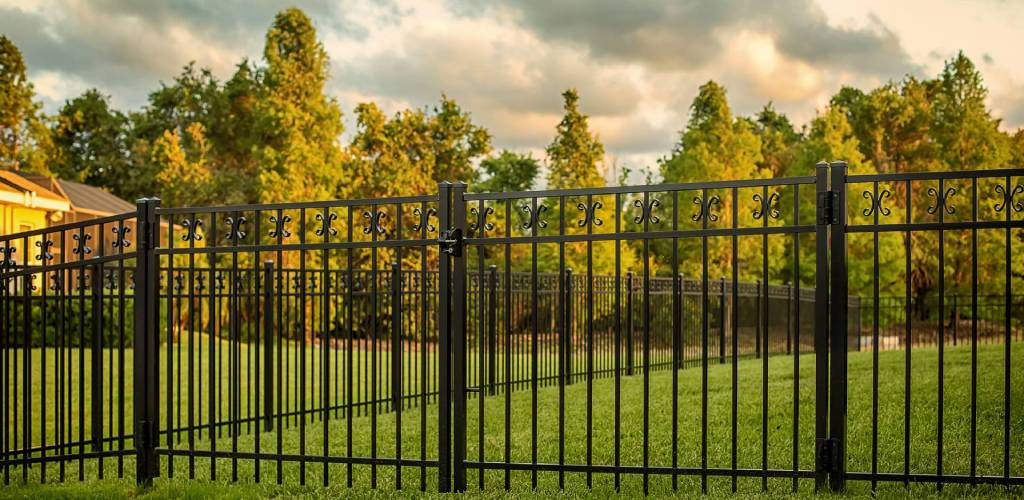All Categories
Featured
As sustainability ends up being an extra substantial worry for property owners and businesses alike, finding environment-friendly choices to traditional fencing materials is significantly essential. From decreasing carbon footprints to preserving sources, green fencing options offer many environmental benefits. In this message, we will discover a number of sustainable fence materials that can aid you develop a durable and eco-conscious boundary for your property.
![]()
Ecological Advantages: Bamboo soaks up co2 and launches oxygen at a much faster price than various other plants, making it an excellent option for decreasing greenhouse gases. It likewise requires little to no chemicals or plant foods, even more reducing its ecological influence. Longevity: Bamboo is resistant and naturally strong to parasites, decay, and wetness, making it an exceptional fencing option for long-term use. If appropriately dealt with, it can also hold up against rough climate conditions. Aesthetic Allure: Bamboo offers a unique and sophisticated look that functions well in different design systems, consisting of exotic, Zen, and modern-day metropolitan atmospheres. While bamboo calls for some upkeep, such as normal cleaning up and sealing, it is a very lasting and trendy choice for green secure fencing.
Environmental Benefits: By picking recycled wood, you are aiding to reduce logging and prevent beneficial products from being disposed of. In addition, repurposing wood conserves power that would certainly or else be invested in generating new wood products. Toughness: Recycled timber can be just as solid and durable as freshly sourced wood, particularly if it is effectively dealt with. It might require additional upkeep to shield it from weathering and bugs. Visual Appeal: Recycled timber fencings have a rustic appeal and can add an unique, weather-beaten seek to your home. They can additionally be discolored or repainted to match your personal design. One consideration with recycled timber is that, gradually, it may require even more maintenance contrasted to other materials, however its eco-friendliness makes it worth the initiative.
![]()
Environmental Advantages: Aluminum and steel can be recycled indefinitely without losing high quality. This minimizes the demand for new raw products and the environmental influence of metal production. Longevity: Steel fences are unbelievably resilient, calling for little to no upkeep in time. They are immune to the aspects, including uv, rain, and wind damage, making them lasting. Aesthetic Charm: Metal fences can be personalized in a variety of styles, from modern styles to much more standard appearances. While they may not supply as much personal privacy as timber, they can be utilized to produce stylish, contemporary borders for your residential property. Aluminum and steel fencings are best for those seeking a low-maintenance and lasting alternative that still supplies an eye-catching look.
Ecological Advantages: Living fencings aid boost air quality by soaking up carbon dioxide, and they can likewise sustain wild animals by offering all-natural environments. Additionally, they help in reducing noise contamination and enhance water retention, making them an ecologically valuable option. Sturdiness: While living fencings require more maintenance (regular pruning and care), they can last for numerous years with correct focus. Visual Allure: A living fence supplies a natural and beautiful look, mixing seamlessly right into natural landscapes. It can give privacy and protection while boosting the charm of your property. The drawback is that living fences call for even more effort and time to keep and develop, however they provide lasting environmental advantages that far surpass the work involved.
![]()
Ecological Advantages: Hemp expands promptly, calls for little water, and needs no pesticides, making it an eco friendly option for fence. It additionally assists to restore dirt wellness and lowers the need for chemical fertilizers. Longevity: Hemp fencings are sturdy, resilient, and immune to mold and mildew and pests, supplying trusted protection for your building. Nevertheless, hemp fencing is still a fairly brand-new choice, and availability may vary. Aesthetic Allure: Hemp fencings have a natural and one-of-a-kind look, typically appearing like woven internet or floor coverings, and can be made use of to produce appealing, eco-conscious limits. Hemp fence is not yet as widely readily available as other materials, yet it's an encouraging environment-friendly choice that is acquiring grip.
Final Thought: Choose Eco-Friendly Fencing for a Lasting Future. When it involves picking the ideal fencing for your home, environmentally friendly alternatives such as bamboo, recycled wood, metal, living fences, and hemp are excellent choices for those that prioritize sustainability. These products not just add to lowering ecological impact yet likewise give resilient, attractive borders that boost your residential or commercial property's curb appeal. Whether you're seeking to produce privacy, improve safety and security, or just include a visual touch, environmentally friendly secure fencing products supply an option that is both stunning and liable.

- Bamboo Fence: A Fast-Growing Renewable Energy. Bamboo is one of one of the most sustainable materials offered for fence. Unlike conventional woods, bamboo grows exceptionally rapidly, with some species reaching maturity in just 3-5 years. This makes it a highly renewable energy, as it can be harvested without harming the environment or the plant.
Ecological Advantages: Bamboo soaks up co2 and launches oxygen at a much faster price than various other plants, making it an excellent option for decreasing greenhouse gases. It likewise requires little to no chemicals or plant foods, even more reducing its ecological influence. Longevity: Bamboo is resistant and naturally strong to parasites, decay, and wetness, making it an exceptional fencing option for long-term use. If appropriately dealt with, it can also hold up against rough climate conditions. Aesthetic Allure: Bamboo offers a unique and sophisticated look that functions well in different design systems, consisting of exotic, Zen, and modern-day metropolitan atmospheres. While bamboo calls for some upkeep, such as normal cleaning up and sealing, it is a very lasting and trendy choice for green secure fencing.
- Recycled Wood Fence: Giving Old Materials New Life. Recycled timber is one more exceptional environmentally friendly secure fencing option. Making use of redeemed timber from old barns, pallets, or other structures can help minimize the need for recently collected wood, saving trees and decreasing waste in landfills.
Environmental Benefits: By picking recycled wood, you are aiding to reduce logging and prevent beneficial products from being disposed of. In addition, repurposing wood conserves power that would certainly or else be invested in generating new wood products. Toughness: Recycled timber can be just as solid and durable as freshly sourced wood, particularly if it is effectively dealt with. It might require additional upkeep to shield it from weathering and bugs. Visual Appeal: Recycled timber fencings have a rustic appeal and can add an unique, weather-beaten seek to your home. They can additionally be discolored or repainted to match your personal design. One consideration with recycled timber is that, gradually, it may require even more maintenance contrasted to other materials, however its eco-friendliness makes it worth the initiative.
- Steel Fence: Resilient and recyclable. Metal fencing, particularly aluminum and steel, is a environmentally friendly and resilient choice. These products can be made from recycled metals, minimizing the demand for mining and raw material extraction, both of which are energy-intensive processes.

Environmental Advantages: Aluminum and steel can be recycled indefinitely without losing high quality. This minimizes the demand for new raw products and the environmental influence of metal production. Longevity: Steel fences are unbelievably resilient, calling for little to no upkeep in time. They are immune to the aspects, including uv, rain, and wind damage, making them lasting. Aesthetic Charm: Metal fences can be personalized in a variety of styles, from modern styles to much more standard appearances. While they may not supply as much personal privacy as timber, they can be utilized to produce stylish, contemporary borders for your residential property. Aluminum and steel fencings are best for those seeking a low-maintenance and lasting alternative that still supplies an eye-catching look.
- Living Fences: Nature's Own Obstacle. Living fences, or hedgerows, are a environmentally friendly and all-natural choice to traditional fence products. These fences are comprised of dense shrubs, trees, or creeping plants that expand to form a limit.
Ecological Advantages: Living fencings aid boost air quality by soaking up carbon dioxide, and they can likewise sustain wild animals by offering all-natural environments. Additionally, they help in reducing noise contamination and enhance water retention, making them an ecologically valuable option. Sturdiness: While living fencings require more maintenance (regular pruning and care), they can last for numerous years with correct focus. Visual Allure: A living fence supplies a natural and beautiful look, mixing seamlessly right into natural landscapes. It can give privacy and protection while boosting the charm of your property. The drawback is that living fences call for even more effort and time to keep and develop, however they provide lasting environmental advantages that far surpass the work involved.

- Hemp Fencing: Lasting and all-natural. Hemp is a fast-growing and environmentally friendly plant that can be used to create sustainable secure fencing. Hemp fibers are strong, eco-friendly, and resistant to bugs and mold, making it a wonderful alternative for developing fencings.
Ecological Advantages: Hemp expands promptly, calls for little water, and needs no pesticides, making it an eco friendly option for fence. It additionally assists to restore dirt wellness and lowers the need for chemical fertilizers. Longevity: Hemp fencings are sturdy, resilient, and immune to mold and mildew and pests, supplying trusted protection for your building. Nevertheless, hemp fencing is still a fairly brand-new choice, and availability may vary. Aesthetic Allure: Hemp fencings have a natural and one-of-a-kind look, typically appearing like woven internet or floor coverings, and can be made use of to produce appealing, eco-conscious limits. Hemp fence is not yet as widely readily available as other materials, yet it's an encouraging environment-friendly choice that is acquiring grip.
Final Thought: Choose Eco-Friendly Fencing for a Lasting Future. When it involves picking the ideal fencing for your home, environmentally friendly alternatives such as bamboo, recycled wood, metal, living fences, and hemp are excellent choices for those that prioritize sustainability. These products not just add to lowering ecological impact yet likewise give resilient, attractive borders that boost your residential or commercial property's curb appeal. Whether you're seeking to produce privacy, improve safety and security, or just include a visual touch, environmentally friendly secure fencing products supply an option that is both stunning and liable.
Latest Posts
Protect Your Home with Rain Gutter Solutions for Illinois Climate
Published Apr 20, 25
2 min read
Change Your Home with Quality Flooring Solutions
Published Apr 19, 25
1 min read
NAPA AutoCare Certified: Count on Montclare Auto Repair for Top-Tier Repairs
Published Apr 19, 25
2 min read
More
Latest Posts
Protect Your Home with Rain Gutter Solutions for Illinois Climate
Published Apr 20, 25
2 min read
Change Your Home with Quality Flooring Solutions
Published Apr 19, 25
1 min read
NAPA AutoCare Certified: Count on Montclare Auto Repair for Top-Tier Repairs
Published Apr 19, 25
2 min read